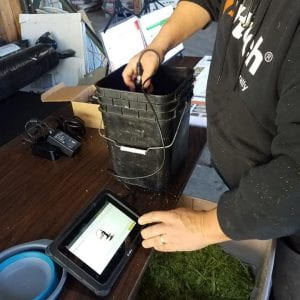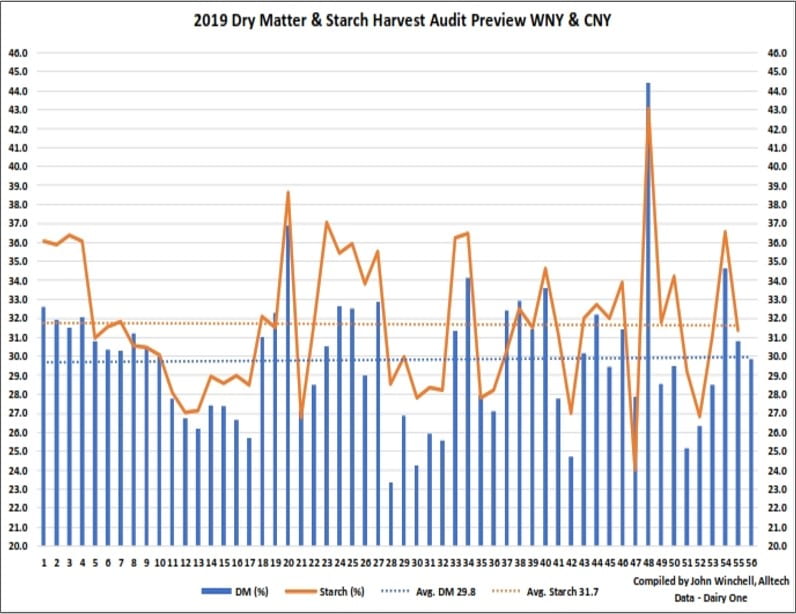Last week, the SCNY Dairy & Field Crops Team held a traditional corn “burn down” at Ward & Van Scoy in Owego, but with a modern twist. John Winchell from Alltech brought his portable NIR, which gives dry matter readings (along with starch and fiber numbers, among others) to help stage the harvest. Producers in the region brought several stalks from each field to be chipped down and tested by the portable NIR. While working through the 26 corn silage samples, producers were able to talk with specialists about their specific situation and when they should start chopping. The traditional “burn down” method of drying samples in a Koster Tester typically takes 45 minutes, and the team would have had 4-6 Kosters running at once. With the NIR, each sample only takes 30 seconds to read, and producers were able to stop in for a few minutes and get results almost instantaneously.
John Winchell offered his observations via email:
I hope everyone is enjoying this Indian summer that we really did need. I have been working on assisting feed mills and consultants and farms with sequencing and planning chopping dates. I have had a lot of success with the spring GDD with harvesting haylage to maximize NDFD30 and minimize undf240. I have been using GDD on corn silage, which is not new, but is getting more robust. I use this as a great tool to dial in to when we should check whole plant DM.
I have over 50 samples chipped in the last two weeks. I am also utilizing NIR4FARM portable NIR testing to look at forages for DM, CP, ADF, NDF, Starch, WSC. It is very accurate on DM, compared to other portable units that I have seen. It is currently being distributed by Dairy One. I am confident on the CP, fiber, and starch numbers that I am seeing.
As for the [average corn silage] results, I am seeing:
- Percent DM: 29.8
- Percent Starch: 31.7
Normally DM and starch will be close in numbers as the plant begins to mature. This season, I have noticed the kernals have less moisture, even if not dented. I am also seeing this with the NIR4Farm Portable, as the starch is out trending the DM.
This is very important in the fact that many farms still use visual inspection as well as milk line as a guide for silage harvest. These parameters can be correct, but more often can be misleading. The plant is no stress or blight, will continue to look green and healthy, but the ear will still mature. That is why whole plant is so critical. For the farms that still do not have a processor, or farms that are not aware of the whole plant dry matter will not process the kernels correctly.
Plants that I have been routinely checking are drying down at 0.5% per day. If corn silage whole plant DM is under 26, it will be slower than 0.5%. But if over 27% DM, and the plant is healthy, you can expect the 0.5%. The old rule of 45 days from fresh green silk, is not working this year, due to temperatures. Cornell and Joe Lawrence suggest that farms track when the corn tassels and then 800 GDD from there, will get you to about 32% DM. Then it is good to start chipping and checking DM.
I have heard many farms are going to start chopping the 1st week of October, which might be too soon if they are not checking whole plant DM. With frost not likely the next two weeks, we should suggest to wait unless they are out of feed, or have many acres to cover.
With later harvesting and later crops, we should expect mycotoxins to be a risk on some farms and some fields. I am currently looking at green samples and doing a harvest analysis on corn silage. More info to come.
If you need any help with sequencing or GDD or seeing the NIR4Farm, let me know. I am happy to assist.
The team is planning on holding another “burn down” at Tully Ag Center on Monday, September 30th. If you are unable to come out on Monday, samples may be dropped off at the Cortland CCE office by noon on Monday, or we can help stage corn at a later date. When discussing harvest strategy, your farm’s setup is critical – if corn is processed or not, presence of blight, whether corn is going into an upright silo, bunk or bag, and the length of time it takes for the corn harvest to be complete.
Come to the burn down to work through your scenario, or call Janice or Betsy with any questions!



